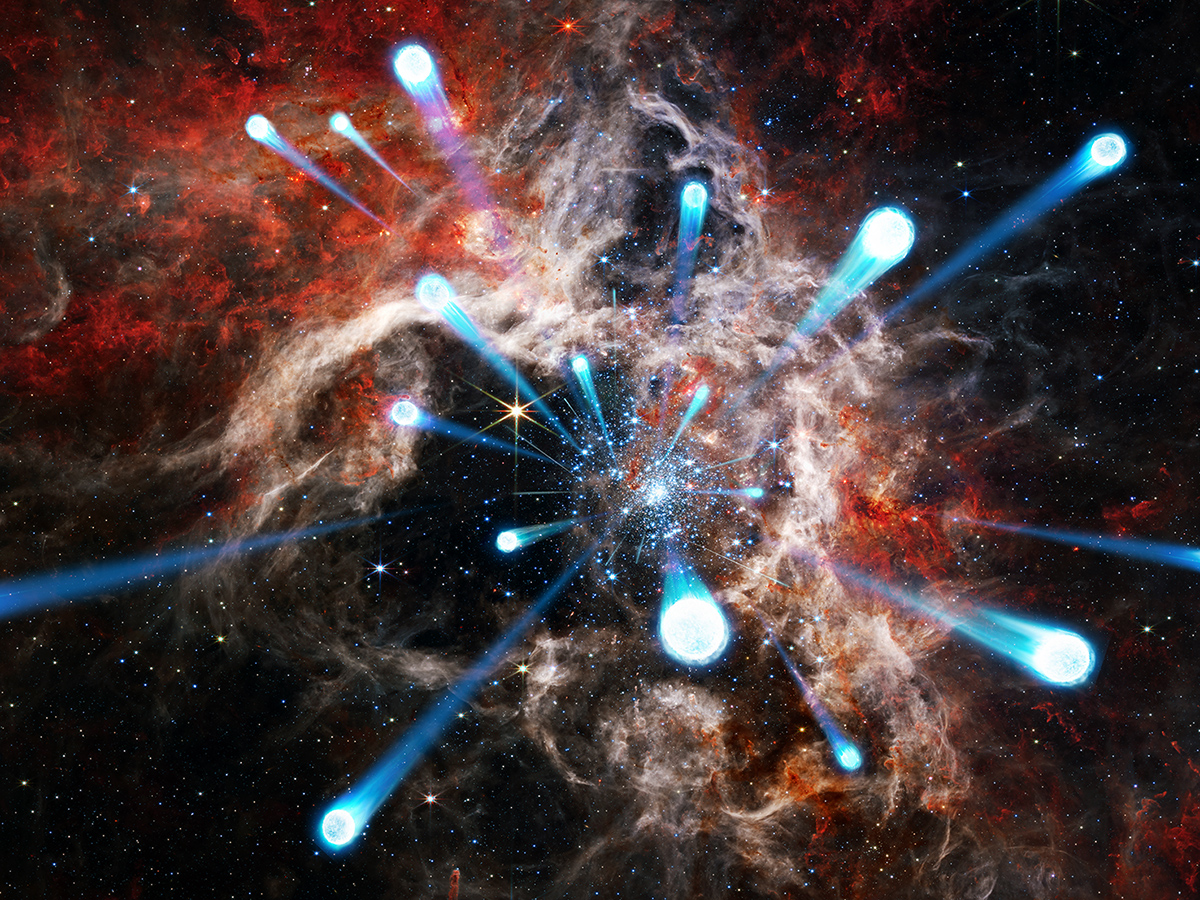Study discovers dozens of runaway stars in young star cluster R136
- This discovery extends the number of massive runaway stars previously identified in this region of the cosmos, some 160 000 light-years away
- The study is a new contribution from the European Space Agency’s Gaia mission, and is published in Nature
- Mark Gieles, IEEC researcher at the Institute of Cosmos Sciences (ICCUB), has a significant role in this research

Caption: Artistic representation of the runaway stars in the cluster R136.
Credits: Danielle Futselaar, James Webb Space Telescope/NIRCam – NASA, ESA, CSA and STScI.
An international science team has discovered 55 high-speed stars ejected from the young star cluster R136, located in the Large Magellanic Cloud—a satellite galaxy of the Milky Way—some 160,000 light-years away. This finding increases the number of known runaway stars in this region of the cosmos tenfold and is a new scientific contribution from the European Space Agency’s (ESA) Gaia telescope, which aims to identify the positions, distances and speed of more than a billion stars in our galaxy. The study is published in the journal Nature.
Runaway stars launched from the young cluster R136—beyond the moon, at a distance of 1.5 million kilometres from Earth—have been identified at extremely far distances for the Gaia mission, ESA’s most ambitious project to detail the stellar mapping of our galaxy. Since its inception, astronomers from teams at the Department of Quantum Physics and Astrophysics of the University of Barcelona, the Institute of Cosmos Sciences of the University of Barcelona (ICCUB) and the Institute of Space Studies of Catalonia (IEEC — Institut d’Estudis Espacials de Catalunya) have been participating in the Gaia project.
The new study, led by experts from the University of Amsterdam, Leiden University and Radboud University (Netherlands), involves Mark Gieles, IEEC researcher at the ICCUB and ICREA professor of the Faculty of Physics of the UB. Astronomers from the Royal Observatory of Belgium (Belgium), Tel Aviv University (Israel), the Netherlands Institute for Space Research (Netherlands) and the University of Geneva (Switzerland) have also signed the paper.
This is the first time that such a large number of high-speed stars have been detected coming from a single cluster. In particular, R136 is a cluster of particular characteristics, containing hundreds of thousands of stars, including the most massive stars known (up to three hundred times the mass of the Sun), and is part of the largest known star-forming region within five million light-years.
Runaway stars at high speeds in the Large Magellanic Cloud
When star clusters form, collisions between smaller star clusters that move can cause the ejection of stars from the young cluster. The science team led by Mitchel Stoop, a PhD student at the University of Amsterdam, has found that the young cluster R136 has ejected up to a third of its most massive stars outwards in the last few million years, at speeds of over 100,000 km/h. These stars travel up to 1,000 light-years from their birthplace before exploding as supernovae at the end of their stellar life and giving rise to a neutron star or black hole.
Another surprising result of the study indicates that there was not a single period when stars were dynamically ejected, but two. According to Scoop, “the first episode was 1.8 million years ago, when the cluster formed, and fits with the ejection of stars during the formation of the cluster”. “The second episode was only 200,000 years ago and had very different characteristics. For example, the runaway stars of this second period moved more slowly and did not shoot off in random directions as in the first episode, but in a preferred one”, says the expert.
Gieles says that “a lot happens in a short time during the formation of massive star clusters and the images only provide a snapshot”. He adds that “these new observations of the motion of escaping stars are like a ‘rearview mirror’, giving us an unprecedented view of what happened before”.
It is worth recalling that the Dutch astronomer Adriaan Blaauw (1914-2010) identified the first indications of the existence of runaway stars, i.e. stars moving at high speed through the Milky Way. With this discovery, Blaauw opened one of the most exciting and surprising chapters in astronomy and cosmology research, which has been unravelling its mysteries thanks to an initial ESA mission—called Hipparcos—and now continues to bear fruit with the Gaia telescope.
Press release prepared in collaboration with the Institute of Cosmos Sciences.
More information
This research is presented in a paper entitled “Two waves of massive stars running away from the young cluster R136”, by Stoop, Mitchell; de Koter, Alex. et al., to appear in the journal Nature on 9 October 2024. DOI: 10.1038/s41586-024-08013-8.
Contacts
IEEC Communication Office
Castelldefels, Barcelona
E-mail: comunicacio@ieec.cat
Lead Researcher at the IEEC
Castelldefels, Barcelona
Mark Gieles
Institute of Space Studies of Catalonia (IEEC)
Institute of Cosmos Sciences (ICCUB)
E-mail: mgieles@ieec.cat, mgieles@icc.ub.edu
About the IEEC
The Institute of Space Studies of Catalonia (IEEC — Institut d’Estudis Espacials de Catalunya) promotes and coordinates space research and technology development in Catalonia for the benefit of society. IEEC fosters collaborations both locally and worldwide and is an efficient agent of knowledge, innovation and technology transfer. As a result of more than 25 years of high-quality research, done in collaboration with major international organisations, IEEC ranks among the best international research centres, focusing on areas such as: astrophysics, cosmology, planetary science, and Earth Observation. IEEC’s engineering division develops instrumentation for ground- and space-based projects, and has extensive experience in working with private or public organisations from the aerospace and other innovation sectors.
The IEEC is a non-profit public sector foundation that was established in February 1996. It has a Board of Trustees composed of the Generalitat de Catalunya, Universitat de Barcelona (UB), Universitat Autònoma de Barcelona (UAB), Universitat Politècnica de Catalunya · BarcelonaTech (UPC), and the Spanish Research Council (CSIC). The IEEC is also a CERCA centre.
